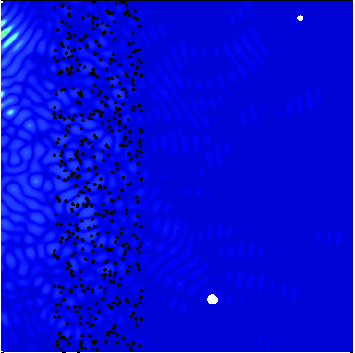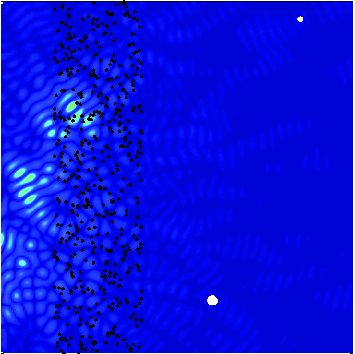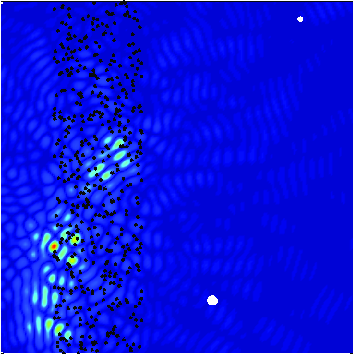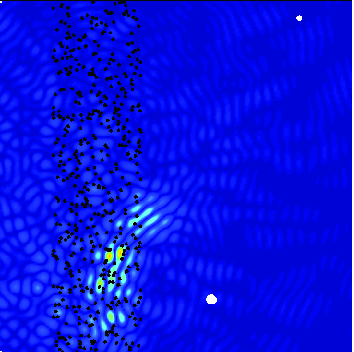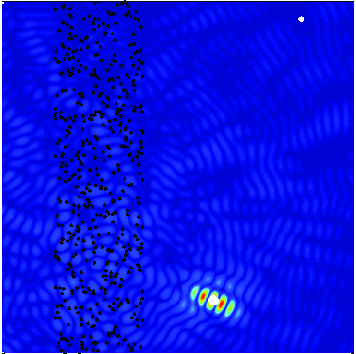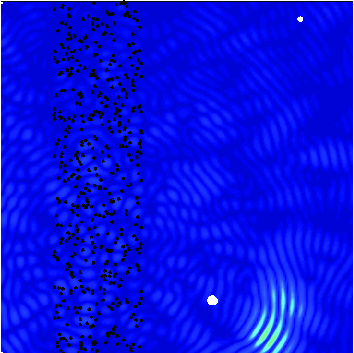Section: New Results
Imaging and inverse problems
Sampling methods in waveguides
Participants : Laurent Bourgeois, Sonia Fliss, Eric Lunéville, Anne-Claire Egloffe.
First, we have adapted the modal formulation of sampling methods (Linear Sampling Method and Factorization Method) to the case of a periodic waveguide in the acoustic case. This study is based on the analysis of the far field of scattering solutions in cylindrical waveguides, in particular for the fundamental solution, which enables us to obtain a far field formulation of sampling methods, and then a modal formulation of such methods. The aim of the inverse problem is to retrieve a defect (that is a loss of periodicity) from the scattered fields which correspond to the incident fields formed by the Floquet modes. Some convincing numerical experiments have shown the feasibility of the method. Secondly, going back to the homogeneous waveguide in the acoustic case, we have started a study of the sampling methods in a more realistic situation, that is the data (emission and reception) are measured on the boundary of the waveguide in the time domain. This was the subject of Anne-Claire Egloffe's post-doc. The aim is to use the modal formulation of the sampling methods at all frequencies and recompose the best possible image of the defect. Some first encouraging results have been obtained when the spectrum of the incident signal is centered at a rather low frequency (corresponding to 3 propagating guided modes).
Space-time focusing on unknown scatterers
Participants : Maxence Cassier, Patrick Joly, Christophe Hazard.
This topic concerns the studies about time-reversal in the context of Maxence Cassier's thesis. We are motivated by the following challenging question: in a propagative medium which contains several unknown scatterers, how can one generate a wave that focuses selectively on one scatterer not only in space, but also in time? In other words, we look for a wave that `hits hard at the right spot'. Such focusing properties have been studied in the frequency domain in the context of the DORT method (“Decomposition of the Time Reversal Operator”). In short, an array of transducers first emits an incident wave which propagates in the medium. This wave interacts with the scatterers and the transducers measure the scattered field. The DORT method consists in doing a Singular Value Decomposition (SVD) of the scattering operator, that is, the operator which maps the input signals sent to the transducers to the measure of the scattered wave. It is now well understood that for small and distant enough scatterers, each singular vector associated with a non zero singular value generates a wave which focuses selectively on one scatterer. Can we take advantage of these spatial focusing properties in the frequency domain to find the input signals which generate a time-dependent wave which would be also focused in time? Since any frequency superposition of a family of singular vectors associated with a given scatterer leads to a spatial focusing, the main question is to synchronize them by a proper choice of their phases. The method we propose is based on a particular SVD of the scattering operator related to its symmetry. The signals we obtain do not require the knowledge of the locations of the scatterers. We compare it with some “optimal” signals which require this knowledge. Our study is illustrated by a two dimensional acoustic model where both scatterers and transducers are assumed pointlike (see figure 6 ).
|
The exterior approach to retrieve obstacles
Participant : Laurent Bourgeois.
This theme is a collaboration with Jérémi Dardé from IMT (Toulouse). The aim is to find a fixed Dirichlet obstacle in a bounded domain by using some redundant boundary conditions (Cauchy data) on the accessible part of the boundary, while the boundary conditions are unknown on the inaccessible part of the boundary. We wish to adapt the exterior approach developped for the Laplace equation and the Stokes system to the case of time evolution problems, in particular the heat equation. The exterior approach consists in defining a decreasing sequence of domains that converge in some sense to the obstacle. More precisely, such iterative approach is based on a combination of a quasi-reversibility method to update the solution of the ill-posed Cauchy problem outside the obstacle obtained at previous iteration and of a level set method to update the obstacle with the help of the solution obtained at previous iteration. We have already introduced two different mixed formulations of quasi-reversibility for the ill-posed heat equation with lateral Cauchy data in order to use standard Lagrange finite elements.
Uniqueness and stability of inverse problems
Participant : Laurent Bourgeois.
In collaboration with Laurent Baratchart and Juliette Leblond from APICS (Nice), we have proved uniqueness for the inverse Robin problem with a boundary coefficient in in the 2D case, for the Laplace equation in the divergence form. The result is based on complex analysis. We have also established an abstract Lipschitz stability result for inverse problems such that the set of parameters is a compact and convex subset of a finite dimensional space. In particular, such result can be applied to the previous inverse Robin problem.
Interior transmission problem
Participant : Anne-Sophie Bonnet-Ben Dhia.
This work is in collaboration with Lucas Chesnel (Aalto University, Finland). During this year, we investigated a two-dimensional interior transmission eigenvalue problem for an inclusion made of a composite material. This problem plays a central role in the theory of the corresponding inverse problem. We considered configurations where the difference between the parameters of the composite material and the ones of the background change sign on the boundary of the inclusion. In a first step, under some assumptions on the parameters, we extended the variational approach of the T-coercivity to prove that the transmission eigenvalues form at most a discrete set. In the process, we also provided localization results. Then, we study what happens when these assumptions are not satisfied. The main idea is that, due to very strong singularities that can occur at the boundary, the problem may lose Fredholmness in the natural framework. Using Kondratiev theory, we proposed a new functional framework where the Fredholm property is restored.
Flaw identification using elastodynamic topological derivative or transmission eigenvalues
Participants : Marc Bonnet, Rémi Cornaggia.
This work is in collaboration with C. Bellis (LMA, CNRS, Marseille), F. Cakoni (Univ. of Delaware, USA) and B. Guzina (Univ. of Minnesota, USA). The concept of topological derivative (TD) quantifies the perturbation induced to a given cost functional by the nucleation of an infinitesimal flaw in a reference defect-free body, and may serve as a flaw indicator function. In this work, the TD is derived for three-dimensional crack identification exploiting over-determined transient elastodynamic boundary data. This entails in particular the derivation of the relevant polarization tensor, here given for infinitesimal trial cracks in homogeneous or bi-material elastic bodies. Simple and efficient adjoint-state based formulations are used for computational efficiency, allowing to compute the TD field for arbitrarily shaped elastic solids. The latter is then used as an indicator function for the spatial location of the sought crack(s). The heuristic underpinning TD-based identification, which consists in deeming regions where the TD is most negative as the likeliest locations of actual flaws and on formulating higher-order topological expansions in the elastodynamic case, has (with C. Bellis and F. Cakoni) been given a partial justification within the limited framework of acoustic inverse scattering using far-field data. Current investigations (M. Bonnet, R. Cornaggia) include setting up and justifying the formulation of higher-order topological expansions for the elastostatic and elastodynamic cases.
Another ongoing research on a related topic addresses the use of transmission eigenvalues (TEs), i.e. values of the wave number for which the homogeneous interior transmission problem (ITP) related to the scattering scattering of time-harmonic elastic waves by aninhomogeneity admits non-trivial solutions. This works (R. Cornaggia, in collaboration with C. Bellis, F. Cakoni, B. Guzina) aims on the one hand to understand better how to compute the TEs -if any- in the case where 's characteristics vary periodically. On the other hand it looks for how a previously obtained knowledge of the TE set could be the basis of an identification process. In a preliminary study considering 1-D elastic beams with periodically varying section over a length , gradient elasticity was found to be a well-suited homogenization model to both compute the TEs and identify , the periodic cell length and the damage parameter from available values of the TEs.
Topological derivative in anisotropic elasticity
Participant : Marc Bonnet.
This work is in collaboration with G. Delgado (PhD student, CMAP Ecole Polytechnique and EADS IW). Following up on previous work on the topological derivative (TD) of displacement-based cost functionals in anisotropic elasticity, a TD formula has been derived and justified for general cost functionals that involve strains (or displacement gradients) rather than displacements. The small-inclusion asymptotics of such cost functionals are quite different than in the previous case, due to the fact that the strain perturbation inside an elastic inclusion has a finite, nonzero asymptotic value in the limit of a vanishingly small inclusion. Cost functionals of practical interest having this format include von Mises equivalent stress (often used in plasticity or failure criteria) and energy-norm error functionals for coefficient-identification inverse problems. This TD formulation has been tested on 2D and 3D numerical examples, some of them involving anisotropic elasticity and nonquadratic cost functionals.
Energy functionals for elastic medium reconstruction using transient data
Participant : Marc Bonnet.
This work is in collaboration with W. Aquino (Duke Univ., USA). Energy-based misfit cost functionals, known in mechanics as error in constitutive relation (ECR) functionals, are known since a long time to be well suited to (electrostatic, elastic,...) medium reconstruction. In this ongoing work, a transient elastodynamic version of this methodology is developed, with emphasis on its applicability to large time-domain finite element modeling of the forward problem. The formulation involves coupled transient forward and adjoint solutions, which greatly hinders large-scale computations. A computational approach combining an iterative treatment of the coupled problem and the adjoint to the discrete Newmark time-stepping scheme is found to perform well on cases where both the FE model and the identification problem are of large size (2D and 3D elastodynamic numerical experiments made so far involve up to half a million unknown for the discretized inverse problem), making the time-domain ECR functional a worthwhile tool for medium identification.



